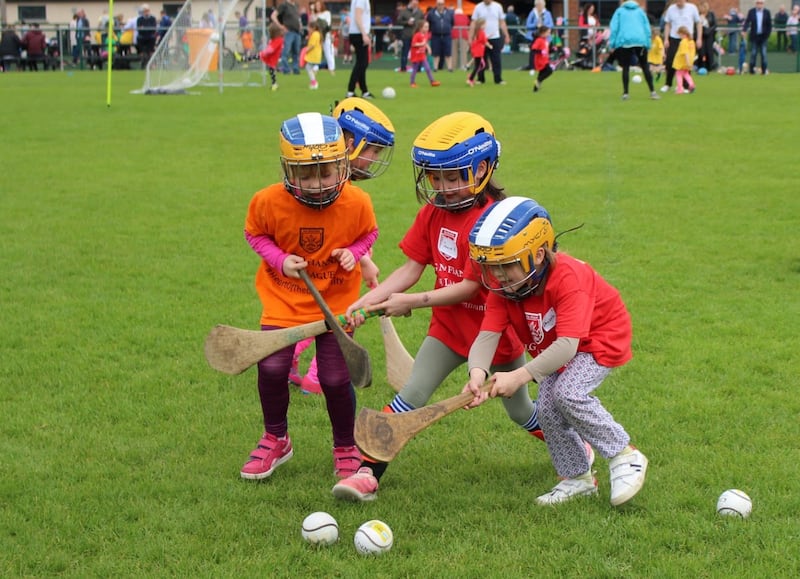Both rural and urban GAA clubs face increasing challenges as demographics in Ireland change. This is one of a series of articles exploring the issues clubs face and what they are doing to adapt.
On the Saturday before Christmas, we were in the hall of Sean McDermotts GAA club in Monaghan to see Santa. The Seans are based in Threemilehouse, which is a village that stands, yes, three miles from the outskirts of Monaghan town and is exactly as big as you think it is. It wasn’t my club growing up but somehow both of my sisters have married into it over the years. So we brought the Dublin child up the road to hang out with her cousins.
It was a mighty afternoon. The whole club turned out and took tea and danced to Christmas tunes and everyone got their go in Santa’s grotto. In a club that size, everyone knows everyone’s name and it’s no hardship to pass the few hours. There wasn’t a ball kicked at any point but instinctively, you knew that this is what a GAA club is. A community gathering point, a natural hub.
Back in Dublin, our club is Na Fianna. The 2015 girls graduated from the nursery last month and next week they’ll start playing Go Games around the place. Every Saturday morning for the past three-ish years (give or take the occasional pandemic), we’ve been down to Mobhi Road in Glasnevin – the child playing, me “coaching”.
READ MORE
The numbers turning up vary due to the weather, proximity to holidays and, most of all, the Toy Show. But given normal conditions, we have about 90 girls every week. That’s 90 girls, not 90 kids – the 2015 boys are on the other pitch in pretty much same numbers. Football one week, camogie the next.
The funny thing is, if you were to draw a red line around the catchment areas for Sean McDermotts in Monaghan and Na Fianna in Dublin, you’d probably capture more or less the same square acreage of Irish soil. The Seans are serviced by the villages of Threemilehouse and Corcaghan and the five kilometres or so of hairy drumlins that lie between them. Na Fianna’s hinterland is most of what sits between Phibsboro and Collins Avenue, a broadly similar distance.
[ The future for GAA clubs: Changing demographics leave rural and urban clubs with major challenges ]
But in population terms, you’re talking about less than 1,000 people in rural Monaghan compared to anything between 80,000 to 100,000 in Dublin 9 and 11. Two vastly different communities and yet both have one GAA club to serve them. For rural clubs, sympathy towards the challenges faced by Dublin super-clubs will be naturally in short supply. But first-world problems don’t go away just because you call them that.
In Na Fianna, we crave space. We have two caged astro pitches to keep things going through the winter. Starting back next week, they’ll be full every night with various age groups crammed in, elbow to elbow. It’s not ideal, it’s just what’s possible.

Across the club, there are somewhere in the region of 200 teams. We play matches in 12 different venues scattered across north Dublin. Some are as near to hand as Johnstown Park, five minutes around the corner. Some are as far away as the RCSI grounds out by Dublin Airport, 20 minutes in good traffic, double that on a bad day. The logistical operation involved in making sure each one is available, single-booked and kept in good working order would fry anyone’s head.
A major problem is keeping everyone connected. Na Fianna have just short of 4,000 members. We have about 1,000 kids playing every week and close to 400 adult players. Each age group is basically its own republic – it’s difficult for our 2015 girls to feel that they’re part of the same organism as, say, the 2011 boys or the U-16 camogie teams. Everybody knowing everybody’s name is something that comes for free in a club like the Seans. In all truth, it’s not really possible at Na Fianna.
As with all clubs, retention is the ultimate goal. How many of those 180-odd kids that come into the nursery every year will still be Na Fianna players when they’re heading off to college? What’s a good number?
Well, this year, it looks like we’re going to field four minor teams in women’s football and three at that age group in camogie. There’ll be a fair bit of dual-player crossover and plenty will have joined the club at different stages. But it essentially means Na Fianna have held on to upwards of 50 of the 2006 girls and delivered them to minor level.
Success is always hard to define. Until we get a better one, that’s not too bad.




















